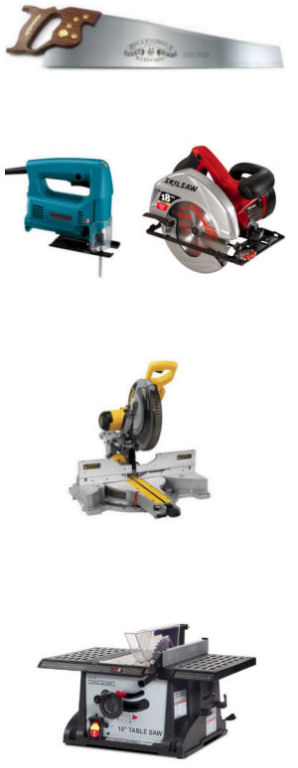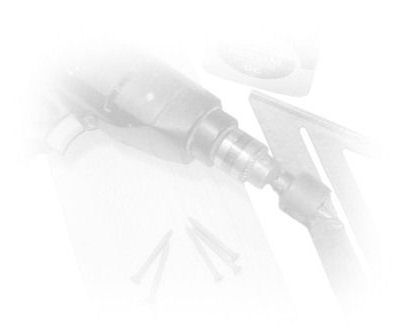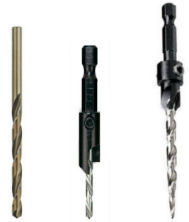



Tools
Building a nestbox tutorials
Nestbox Materials
Tools
Fasteners
Entrance Holes
Adhesives and Caulk
Finishing
Nestbox Materials
Tools
Fasteners
Entrance Holes
Adhesives and Caulk
Finishing
Home | Site Map | Disclaimer | Contact Us
Copyright © 2012 NestboxBuilder.com
This site was last updated on 01/01/2016
Copyright © 2012 NestboxBuilder.com
This site was last updated on 01/01/2016
A nestbox is a fairly simple structure and can built with a minimum of tools:
- Safety equipment (see bottom of this page)
- Saw (hand or power)
- Hammer (if using nails)
- Screwdriver (if using screws)
- A small square (carpenter's square or T-square)
- Electric drill
- Assortment of drill bits
- Tape measure
- Pencil
Forstner bit
Drill bits (left to right): standard twist drill, countersink with pilot bit, countersink with tapered pilot bit
Hole saw with pilot bit
Spade bit
Saws
Hand sawIf you're going to build one or just a few nestboxes, all you need is a "crosscut" hand saw. Crosscut saws have teeth designed to cut wood at right angles to the wood grain, which is the predominant cut you'll be making when building a nestbox.
Power saws
The jig saw and circular (skill) saw are hand held power saws and are the least expensive power options. The jig saw is light and fairly quiet. The circular saw, because of its larger blade, makes a straighter cut.
Standard Miter saws
With a miter saw, the wood is held squarely against a built-in guide (called the fence) and the saw is pulled down onto the wood, producing a straight cut. These saws are available in 10 and 12-inch, which refers to the diameter of the saw blade.
The 12-inch is the better choice of the standard miter saws, as it will cut wider boards in a single pass. Avoid a 10-inch standard miter for nestbox construction, as most models will not completely cut through a 1 x 6, especially when cutting at an angle.
Sliding Miter Saws
The blade of the sliding miter saw can slide forward after making the initial downward cut. This allows cutting any width lumber you'll likely encounter when building a nestbox, even with a 10-inch blade. This would be the ideal power saw for nestbox construction; however, sliding miter saws are more expensive than the standard versions.
Table Saws
The table saw's forte is making rip cuts, which is cutting wide boards into narrow ones. On basic nestboxes, you'll be making crosscuts, which is cutting long boards into shorter ones. To make crosscuts safely on a table saw, you'll need to use an accessory called a miter gauge, which usually comes with the saw. If you're going to buy one power saw, the table saw is not the best choice for nestboxes.
Crosscut hand saw
Jig saw
Circular, or skill saw
Miter saw (sliding shown)
Drill Bits for Entry Holes
Unless you're building a slot box (which has a rectangular entry), you'll need a drill bit (or hole saw) to make the entry hole. There are three types (shown at left).Forstner
The Forstner bit makes the smoothest cut and is the most expensive. Imported Forstner bits are available online, but freight costs usually offset the savings on a single order. If you can find a set that contains the size(s) you need you'll usually save money over buying them individually.
Hole Saw
The hole saw is relatively inexpensive; however, it tends to splinter the wood as it exits the bottom of the cut. To prevent this, drill the hole from one side then flip the panel over and complete the cut from the back side. This technique is shown in our Entrance Holes tutorial.
Spade Bits
Often called "paddle bits", these are relatively inexpensive but produce the least quality of the three bits. Panels drilled with a spade bit should be clamped to keep your hand away from the cutting edges, which stay exposed during the entire cut.
Standard and Countersink Bits
If you plan on using screws to fasten your nestbox together (rather than nails), you'll need a few standard twist drill bits. Rather than buying bits individually, It's usually less expensive to buy a small set of various sizes. A set will be useful later on when mounting your nestbox.Countersinks with pilot bits are useful time savers as they allow you to drill a pilot hole and make a countersink in the same operation.
Table Saw

WARNING: Always read and follow the operating and safety instructions for any tool, attachment or accessory you use in the construction of a nestbox. Wear safety goggles to protect your eyes, gloves to protect your hands, and wear other appropriate safety items for protection, such as respirators to avoid dust inhalation and hearing protection when using loud power tools.

